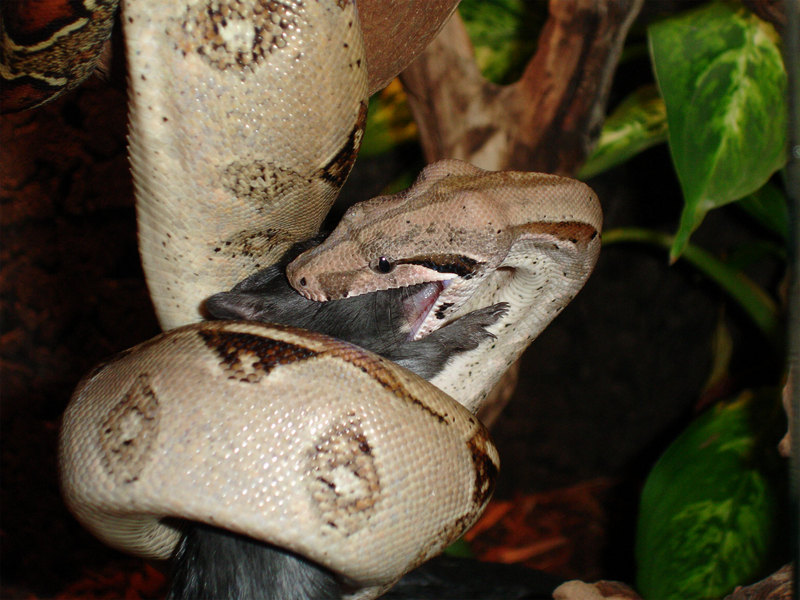Boa constrictor
From Wikipedia, the free encyclopedia
[Photo] Boa constrictor imperator eating. Date: 30 November 2004. Photograf: Jens Raschendorf
The boa constrictor (Boa constrictor ssp.), red-tailed boa, jib??ia (Latin American name) or macajuel (pronounced mah-cah-well) (Trinidadian name) is a species of boa. It represents a rare case of an animal having the same common and scientific name. Though all boa species are constrictors, in that they kill their prey by constriction, only one species is properly called a "boa constrictor."
Description & Habitat
Though sometimes impressively large, boa constrictors are not the giant snakes of the popular imagination. Depending on their geographic origin and sex (females are usually somewhat larger), they can reach from 4 to 12 feet as adults. The largest boa constrictor in captivity is a 14.5-foot long female from Suriname that resides at the San Diego Zoo. Boa constrictors have a pattern of brown, reddish-brown to black "saddles" or dorsal blobs of color on a lighter background which can range through white, golden, grey or brownish, pink. Specimens from most localities have more or less prominent dark red, reddish brown or brown markings on the tail.
Female boas produce live offspring instead of laying eggs. Fertilization by the male is internal. During copulation, males can cling to the female via a small set of "spurs" that are generally hidden below scales on either side of the vent and are actually evolutionary remnants of the hind legs. The gestation period of boas is 108 days after the post ovulation shed.
Subspecies
The species has been divided into a number of sub-species that occur from Mexico to Argentina, as well as on the Caribbean islands of Trinidad and Tobago, Dominica and St. Lucia.
Amaral's Boa, Boa constrictor amarali (Stull, 1932)
Common Red-tailed Boa, Boa constrictor constrictor (Linnaeus, 1758)
Common Northern Boa, Boa constrictor imperator (Daudin, 1803)
Tumbes Peru Boa, Boa constrictor longicauda (Price&Russo, 1991)
Ecuadorian Boa, Boa constrictor melanogaster (Langhammer, 1983)
Dominican Clouded Boa, Boa constrictor nebulosa (Lazell, 1964)
Argentine Boa, Boa constrictor occidentalis (Philippi, 1863)
St. Lucia Boa, Boa constrictor orophias (Linnaeus, 1758)
Orton's Boa, Boa constrictor ortonii (Cope, 1878)
Pearl Island Boa, Boa constrictor sabogae (Barbour, 1906)
Ecology
The boa constrictor's diet ranges from small rodents and lizards to large birds, marmosets, coatimundi, iguana and opposums, as well as bats, catching them as they hang in trees or caves, or snatching them as they fly by. They locate prey via heat sensitive scales on their snout, as well as by scent.
Large boas are occasionally preyed upon by jaguars and caimans, smaller subspecies may be eaten by a variety of animals, including various jungle cats, tayra, birds of prey, and even some species of crab.
In Captivity
Boa constrictors do well in captivity, usually becoming quite tame, and are a common sight in zoos. They can live up to 20 to 30 years old in captivity, with rare accounts of over 40 years old, making them a long-term commitment as a pet. Animal husbandry is the most significant factor in captive lifespan.
While still imported in significant numbers, boa constrictors are widely bred in captivity, both for the casual pet trade and among serious herpetocultural hobbiests. In addition to normal-appearing specimens, animals exhibiting a wide variety of color and pattern mutations (e.g. albinism) are being produced. Many of these are quite expensive.
The subspecies most readily available commercially is B. c. imperator, often termed the "common boa" or "Colombian redtail boa," even though its tail markings tend toward brown rather than the deep red or reddish brown of the "true redtail" subspecies, B. c. constrictor. B. c. imperator is a wide-ranging subspecies and its appearance varies greatly with location. Mainland specimens from Colombia can be among the larger boas, but this subspecies also includes a number of dwarf insular populations, such as those from various Carribean islands and the Sonoran desert of Mexico. These populations represent the smallest of the boa constrictors.
In recent years many herpetoculurists, mostly working with B. c. imperator, have dedicated themselves to the reproduction of animals with unusual and sometimes spectacular color and pattern mutations, referred to as "morphs" within the hobby. Specimens with anomalous appearance crop up from time to time among imports, or in captive bred animals. When this occurs, breeders will attempt to breed the animal to its own close relations, often its own offspring. If the issue of these breedings show the same traits, then the trait has been "proven" to be an inheritable genetic mutation. Often breeding programs are established to combine more than one mutation, producing even more unusual-looking animals that would never be seen in nature.
Other herpetoculturists prefer natural-looking animals, and many have focused on producing animals they believe to be representative of those found in particular geographic localities in nature. For example, they may breed only B. c. constrictor specimens from Suriname, or B. c. imperator specimens from Cayo de los Cochinos (Hog Island) off the coast of Honduras. These efforts are often complicated by the uncertain provenance of boa constrictors in captivity. Imported animals often lack collection data, or the data are inaccurate.
http://en.wikipedia.org/wiki/Boa_constrictor
| The text in this page is based on the copyrighted Wikipedia article shown in above URL. It is used under the GNU Free Documentation License. You may redistribute it, verbatim or modified, providing that you comply with the terms of the GFDL. |
|

